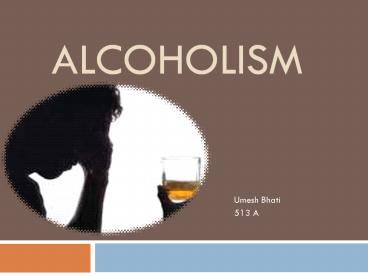Alcoholism - PowerPoint PPT Presentation
1 / 17
Title:
Alcoholism
Description:
ALCOHOLISM Umesh Bhati 513 A The human brain doesn t fully develop until the early 20 s. Alcohol use before then drastically impacts learning and memory. – PowerPoint PPT presentation
Number of Views:71
Avg rating:3.0/5.0
Title: Alcoholism
1
Alcoholism
- Umesh Bhati
- 513 A
2
(No Transcript)
3
- The human brain doesnt fully develop until the
early 20s. Alcohol use before then drastically
impacts learning and memory.
4
Health Consequences of Alcohol Use
- Increased risk of cardiovascular
diseases(Coronary Heart Disease, Stroke,
Hypertension) - Increased risk of cancer(liver, stomach, colon,
pancreas, breast, mouth, throat) - Impaired immune system
- Malnutrition
- Reproductive problems
5
Behavioral Consequences of Alcohol Use
- Contributes to 50 of all motor vehicle
fatalities - Contributes to unsafe sex and increased risk of
AIDS - Contributes to risky behavior and accidental
death
6
Academic Consequences of Alcohol Use
- 40 of poor academic performance at college has
been linked to drinking - 7 of first year dropouts are related to alcohol
7
(No Transcript)
8
Why People Start Drinking
- Peer pressure
- Need to belong and be accepted
- Media depiction of drinking
- Easy access (often at home)
- Absence of religious attachment
- Cultural / sociological traditions
- Social "lubrication"
- Makes one "feel good"
9
There are more than 150 medications that should
not be mixed with alcohol.
- For example, drinking alcohol while taking
acetaminophen (Tylenol) can increase the risk of
serious liver damage.
10
Alcohol affects men and women differently. Women
become more impaired than men from drinking the
same amount of alcohol. This is because women
- Are generally smaller in size
- Have less body water
- Have less dehydrogenase(Dehydrogenase is an
enzyme in the stomach that breaks down alcohol.) - Have more estrogen
11
- Low risk drinking
- 1 drink a day for women
- 2 drinks a day for men
12
- Alcohol is a central nervous system depressant.
- In small amounts it can have a relaxing effect.
- But, in large amounts it can cause impaired
judgement, slurred speech, reduced reaction time,
and difficulty walking.
13
Social factors
- Alcoholism high in some cultures
- Americans, Swiss, Irish, Polish, Russians.
- Low in others
- Chinese, Koreans,
- Orthodox Jews.
14
Alcoholism is low in cultures where
- Children learn alcohol is a beverage.
- Served in dilute forms.
- Abstain okay.
- Parents model moderate drinking
- Getting drunk not seen as comical.
- Everyone knows ground rules.
15
Media images of alcohol
- Ireland has highest heavy drinking rates in
Europe. - Youth bombarded with alcohol ads.
- Have begun to restrict advertising.
- Change the culture.
16
Pharmacology
- Absorbed rapidly form GI tract
Proximal Small Bowel
Stomach Large Bowel
Mouth Esophagus
gtgtgt gtgt
- Rapidly equilibrates in blood and all tissues.
17
Treatment for Alcoholism
- ? Successful treatment/cessation
- Family, friends, peers MUST be supportive
involved - Support groups
- Alcoholics Anon
- Pharmacologic intervention antabuse
- Best if linked to the above































